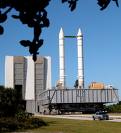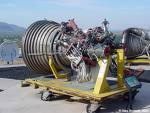ROCKET COMPONENTS
CEPE's second sheet includes all pre-defined stages and engines characteristics. All stages and engines are in the same order as enumerated on the Rocket & Payload Selections sheet. The green cells are data taken directly from reference documents (shown in notes on the sheet). Light green cells are values that had to be estimated as they were not available in those reference documents. The yellow cells are calculated values using entered green cells or other already calculated cells.
 Column B is for SRB's specifications, column E for core stages and their engines and column H for upper stages and their engines. Column B has six boxes used to specify 5 SRBs (CCB of Atlas V, GEM-60 of Delta IV, 4 segments SRB of the original ESAS CLV, 5 segments SRB of original ESAS CaLV and 5.5 segments SRB of the latest/larger Ares V) and a spare box for the user's own design.
Column B is for SRB's specifications, column E for core stages and their engines and column H for upper stages and their engines. Column B has six boxes used to specify 5 SRBs (CCB of Atlas V, GEM-60 of Delta IV, 4 segments SRB of the original ESAS CLV, 5 segments SRB of original ESAS CaLV and 5.5 segments SRB of the latest/larger Ares V) and a spare box for the user's own design.
 Column E is for rocket core tanks specifications and their engines characteristics. Eleven core tanks (Atlas V, Delta IV, Magnum, CaLV (LV27.3), 3 Ares V models, 3 Jupiter models, ET) are defined in column E and a spare box is available for the user's own design. Column D includes the characteristics of 6 main engines (RD-180, 3 RS-68 variants, 2 SSME variants) and a spare box is available for the user's own design.
Column E is for rocket core tanks specifications and their engines characteristics. Eleven core tanks (Atlas V, Delta IV, Magnum, CaLV (LV27.3), 3 Ares V models, 3 Jupiter models, ET) are defined in column E and a spare box is available for the user's own design. Column D includes the characteristics of 6 main engines (RD-180, 3 RS-68 variants, 2 SSME variants) and a spare box is available for the user's own design.
Column H is for rocket upper stage specifications and their engines characteristics. Eleven upper stages (Centaur, 2 Delta IV upper stages, CaLV (LV27.3) EDS, Ares V 8.4 m EDS, Ares V 10 m EDS, CLV (LV13.1) upper stage, Ares I upper stage, 3 Jupiter EDS) as well as the Space Shuttle are defined in column H. Column H includes the characteristics of 6 upper stage engines (2 RL-10 variants, OME, 2 J-2 variants, air started SSME) and a spare box is available for the user's own design.
It should be noted that for the Space Shuttle, the 3 SSMEs are considered to be the ET engines by CEPE and the 2 OMEs the orbiter engines. The number of SSMEs should always be kept at 3 in order to preserve the real ET dry mass (29,930 kg). The OME burnout propellant is arbitarily assumed to be 50% of the total Space Shuttle capacity in order to leave some propellant for the de-orbiting burn at the end of the Space Shuttle mission.
HOW TO USE THE ROCKET COMPONENT SHEET
If you only want to use already defined rocket components, you don't need to use this sheet. Otherwise you need to enter your parameters in a spare box or overwrite an already defined box. You don't have to necessarily enter your parameter in green cells only, as long as you are logical in your selections. For example, the "Burnout prop" added to the "Useful prop" must be equal to the "Total prop".
Let say you want to create a large Lox/Kerosene core stage with the following parameters:
Diameter: 8.4 meters
Empty mass: 100,000 kg
Full mass: 1,700,000 kg
Engines: 5 x RD-180
 You can enter 8.4 in cell E142, 100,000 in cell E143, 1,700,000 in cell E145 and 5 in cell E151. Make sure that you have zero in cells E152 to E157. Enter 1 in cell E146 if you assume that 1% of the total propellant will be left at burnout. From the already entered data, you should be able to figure out the values to be entered in cells E144 (116,000), E147 (16,000), E148 (1,584,000), E149 (1,600,000) and E150 (0.93). Being in yellow, cells E158, E159 and E160 will be calculated automatically by CEPE. To use this newly created core stage, you need to enter 1 in cell E11 of the Rocket & Payload Selections sheet.
You can enter 8.4 in cell E142, 100,000 in cell E143, 1,700,000 in cell E145 and 5 in cell E151. Make sure that you have zero in cells E152 to E157. Enter 1 in cell E146 if you assume that 1% of the total propellant will be left at burnout. From the already entered data, you should be able to figure out the values to be entered in cells E144 (116,000), E147 (16,000), E148 (1,584,000), E149 (1,600,000) and E150 (0.93). Being in yellow, cells E158, E159 and E160 will be calculated automatically by CEPE. To use this newly created core stage, you need to enter 1 in cell E11 of the Rocket & Payload Selections sheet.
